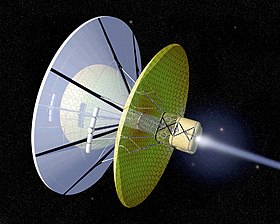captaincranky
Posts: 20,156 +9,152
Well, I don't think we have the energy available to provide constant laser light to begin with. Since you suggest, "the acceleration would be slow", the laser would have to be constant, or at the very least have rapid recycle times. This physicist would have to do some really fast talking to get enough power diverted to pull this off.One other point: the sail would have to be designed to work across a broad spectrum because as the ship's velocity increases, the light from the laser will be dopplered into longer wavelengths. At relativistic velocities, the energy from the laser would be greatly attenuated and would probably cease to be a very effective propulsive force. Just one more limit on the system's effectiveness, but I don't have numbers at hand, so can't put a value on those limits, especially when there are so many variables.
As for Doppler effect, photography 101 tells us the light comes off a speculum in all directions, and can't be polarized. I believe our largest telescopes can be fitted with infrared sensors, so the wavelength of silvered mirrors must be fairly broad band. In the case of digital imaging sensors, most of those are filtered to get rid of infrared. So, long wave red isn't really that hard to trap or reflect. .
.AFAIK. lasers are bandwidth challenged to begin width. So, if we're thinking of a laser shooting imitation sunlight out into space, I think somebody's going to be deeply disappointed anyway.
However, I believe the power required to achieve "C", escalates to formidable levels the closer to moving at "C" a craft would become. So, there's that to consider. The farther away the craft gets, the more power would be required from the light source. Considering the greater the losses would be as the craft receded, supplying the motive force becomes quite an issue.
Then there's the mass required to be moved to Mars to establish a permanent base. We either can't afford or refuse to pay to continue our exploration of the moon. So, how extravagant would the price be for such an endeavor to Mars? Realistically, I think the best propulsive force would be the hot air coming out of Elon Musk's mouth.
Last edited:
